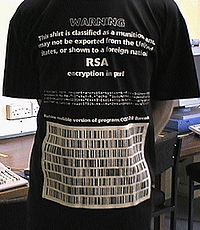
Photo from wikipedia
We show here that the intraplantar administration of CCL5 in mice produces hyperalgesia at low doses but activates compensatory antinociceptive mechanisms at doses slightly higher. Thus, the injection of 3-10ng… Click to show full abstract
We show here that the intraplantar administration of CCL5 in mice produces hyperalgesia at low doses but activates compensatory antinociceptive mechanisms at doses slightly higher. Thus, the injection of 3-10ng of CCL5 evoked thermal hyperalgesia through the activation of CCR1 and CCR5 receptors, as demonstrated by the inhibitory effect exerted by the selective antagonists J113863 (0.01-0.1μg) and DAPTA (0.3-3μg), respectively. The prevention of this hyperalgesia by diclofenac (1-10μg), the inhibitors of COX-1 SC-560 (0.1-1μg) or COX-2 celecoxib (1-5μg), the TRPV1 antagonist capsazepine (0.03-0.3μg) or the TRPA1 antagonist HC030031 (10-50μg) demonstrates the involvement of prostaglandin synthesis and TRP sensitization in CCL5-evoked hyperalgesia. Doses of CCL5 higher than 17μg did not evoke hyperalgesia. However, this effect was restored by the administration of naloxone-methiodide (5μg), nor-binaltorphimine (10mg/kg) or an anti-dynorphin A antibody (0.62-2.5ng). The administration of 30ng of CCL5 also induced hyperalgesia in mice with reduced number of circulating white blood cells in response to cyclophosphamide or with selective neutrophil depletion induced by an anti-Ly6G antibody. In fact, the number of neutrophils present in paws treated with 30ng of CCL5 was greater than in paws receiving the administration of the hyperalgesic dose of 10ng. Finally, the expression of the endogenous opioid peptide dynorphin A was demonstrated by double immunofluorescence assays in these neutrophils attracted by CCL5. These results support previous data describing the hyperalgesic properties of CCL5 and constitute the first indication that a chemokine of the CC group can activate endogenous analgesic mechanisms.
Journal Title: Brain, Behavior, and Immunity
Year Published: 2017
Link to full text (if available)
Share on Social Media: Sign Up to like & get
recommendations!